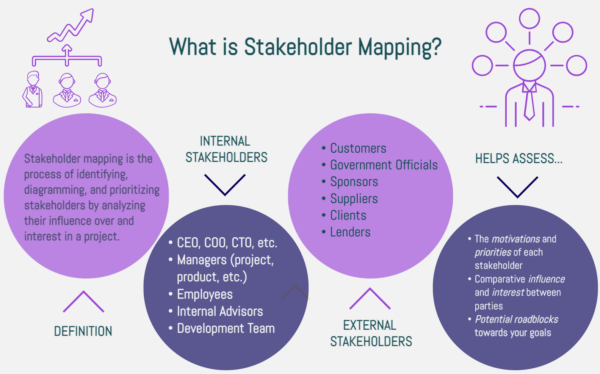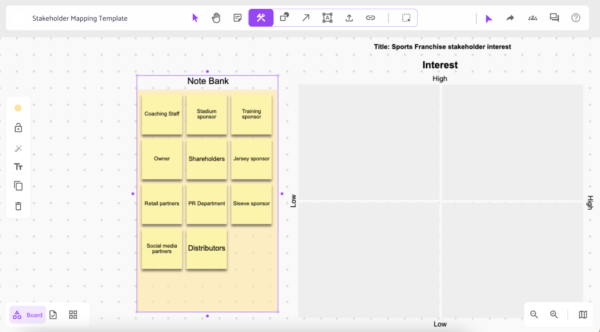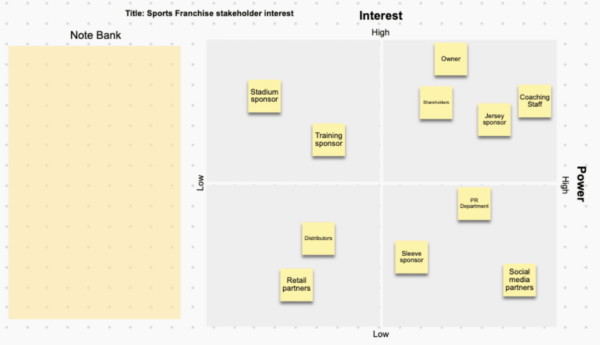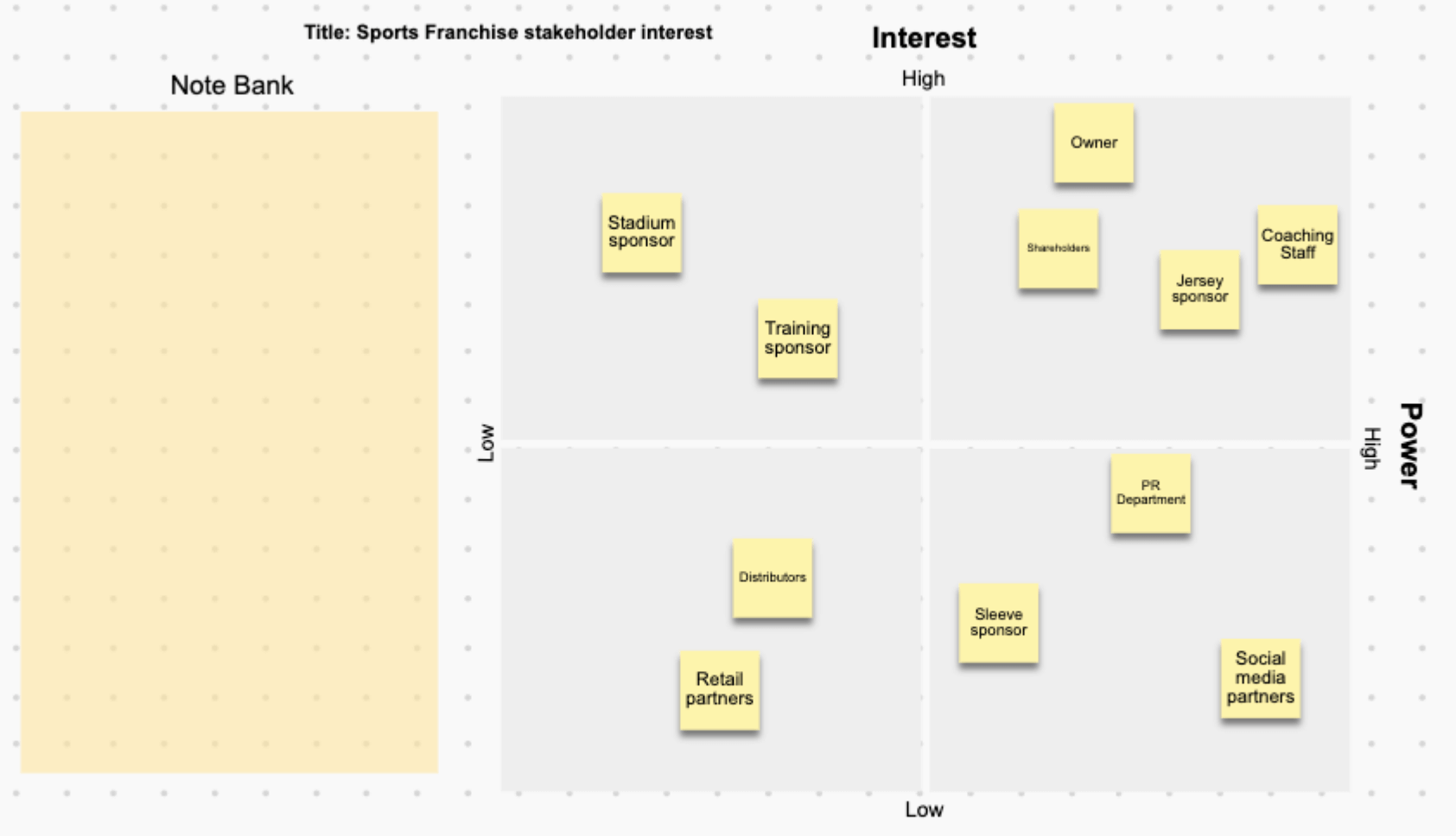Table of Contents
In any project or organizational effort, identifying and understanding the key stakeholders involved is critical to success. Stakeholder mapping is a strategic tool that helps businesses and project managers visually plot the people or groups that have an interest in the project. This process not only ensures better communication but also improves decision-making by identifying who holds influence, who should be kept informed, and how to manage their expectations.
In this article, we’ll explore what stakeholder mapping is, its importance, and how to create an effective stakeholder map to ensure project success.
What is Stakeholder Mapping?
Stakeholder mapping is the process of identifying and categorizing all the individuals, groups, or organizations that have an interest or stake in a project or business. By understanding the needs, influence, and impact of these stakeholders, project teams can prioritize communication and align their strategies to meet stakeholder expectations.
The ultimate goal is to enhance collaboration, avoid misunderstandings, and ensure that all parties are aligned with the project objectives.

Who Are Your Stakeholders?
As previously mentioned, the term “stakeholders” covers more parties than just the shareholders. A stakeholder could be anyone with influence and interest in a given project, whether internal or external. The difference between internal and external stakeholders is key, and understanding the variance between the two will help create clear priorities for your project. Here are some of the differences between internal and external stakeholders.
Internal Stakeholders
Internal stakeholders are people who work with the business building, promoting, delivering, and participating in a project. Their level of involvement may vary, but they all have a direct connection to the project. Some examples of internal stakeholders could be:
- CEO, COO, CTO, etc.
- Managers (project, product, etc.)
- Employees
- Internal Advisors
- Development Team
External Stakeholders
External stakeholders are people who might have some connection to your project but aren’t on the inside. The project will impact them, but they don’t help build it. Some examples of external stakeholders could be:
- Customers
- Government Officials
- Sponsors
- Suppliers
- Clients
- Lenders
Stakeholder mapping is generally beneficial to any business but applies in more specific scenarios. In these scenarios, there will typically be new stakeholders to address and new relationships to consider, so mapping them out can be extremely helpful.
Why is Stakeholder Mapping Important?
Stakeholder mapping is vital for several reasons:
- Clear Communication: By identifying key stakeholders early on, teams can tailor communication strategies to keep everyone informed at the right time.
- Risk Management: Mapping stakeholders helps project managers anticipate potential conflicts or roadblocks and proactively address concerns.
- Prioritization of Efforts: Not all stakeholders have the same level of influence or interest. A stakeholder map helps teams focus their efforts on the most critical stakeholders who can impact the project’s success.
- Improved Decision-Making: Knowing who holds decision-making power within the group allows for more targeted discussions and helps speed up the process.
How to Create a Stakeholder Map
Creating an effective stakeholder map involves several key steps:
- Identify Stakeholders: Start by brainstorming all individuals, teams, organizations, or departments that have an interest in your project. Stakeholders can be internal (employees, managers) or external (customers, suppliers, regulators).
- Analyze Stakeholder Influence and Interest: Group stakeholders based on their level of influence (high or low) and interest (high or low) in the project. This will help you understand how much attention and resources should be allocated to each group.
- Categorize Stakeholders: Use a grid to categorize stakeholders into four main groups:
- High Influence/High Interest: These stakeholders require regular communication and active engagement.
- High Influence/Low Interest: These stakeholders should be kept satisfied but don’t need frequent updates.
- Low Influence/High Interest: Keep these stakeholders informed, as they can offer valuable insights.
- Low Influence/Low Interest: These stakeholders require minimal effort but shouldn’t be overlooked.
- Develop Communication Strategies: Based on the map, create communication strategies for each group, ensuring that your engagement is appropriate to their level of interest and influence.
- Monitor and Adjust: Stakeholder needs and influence can change over time. Regularly review and update the stakeholder map to ensure ongoing project alignment.
Examples of Stakeholder Mapping in Action
Here are a few real-life stakeholder mapping examples:
1. Corporate Social Responsibility (CSR): A company launching a new CSR initiative created a stakeholder map to identify community leaders, employees, customers, and local governments who would be affected by or interested in the project. By tailoring communication and expectations, they successfully aligned all parties around the project’s goals.
2. Product Development: A tech company launching a new product used stakeholder mapping to understand the influence of internal teams like R&D, marketing, and sales, as well as external partners and customers. The map allowed them to prioritize feedback and ensure the product met stakeholder expectations.
3. Public Infrastructure Projects: In public infrastructure projects, government bodies use stakeholder mapping to manage relationships with contractors, local residents, and regulatory agencies. This enables efficient handling of concerns and smooth project execution.
How to Use a Stakeholder Map
Whether you need to understand your stakeholder’s positioning better or need to develop specific solutions for them, a stakeholder map is a great tool to help analyze their needs. Here is a guide to creating a detailed stakeholder map.
Brainstorm Stakeholders
The first step in creating a stakeholder map is brainstorming your internal and external stakeholders. Selecting which stakeholders to include will ultimately come down to preference, but it’s important to consider their influence, interest, past contributions, and potential impact. Additionally, if the goals of your collaborative workshop are different, this might affect who you include. If possible, try to include as many ownership parties as possible and integrate large-budget customers to understand the positioning of the most influential stakeholders.
The stakeholder map begins on an online whiteboard by brainstorming the stakeholders. You will analyze and map them into a note bank beside the matrix. This lets you group them together before considering where they fall on the matrix.
After you brainstorm the stakeholders, you will begin to map them out on the template. There are four sections that we will talk about below, each section corresponding to a different quadrant of the stakeholder map.

Quadrant 1: Monitor
The “monitor” section is at the bottom left of the stakeholder map and corresponds with the lowest level of influence and interest. This portion is where you will gather stakeholders who sit on the outer rim of the project and whose opinions don’t hold much formative say in your decision-making.
The optimal engagement strategy for these stakeholders is to monitor them periodically and stay partially engaged with them. Because they hold some interest but aren’t super engaged, it’s important to ensure that this interest is maintained over time. By monitoring their behavior and engagement, you can better understand what specifically draws them toward your business and what they are looking for. Through this, you can begin to push the things you know to pique their interest in an effort to increase their engagement.
Quadrant 2: Keep Informed
The “keep informed” section falls under high interest, but low influence, meaning many people in this portion will be extremely interested in the business but don’t have significant influence over its direction. An example of a user like this could be a regular customer who uses the product avidly but doesn’t have any influence on its direction.
With these stakeholders, it’s important to keep them informed and in the loop while maintaining their level of interest. While they might not have a formative say in the product, they feel more important when they’re filled in on the evolution of your business.
These stakeholders will be informed about the business and will be a key source of feedback as they continue to interact with the product/service. To receive consistent feedback, it’s key to maintain the stakeholder’s level of interest through product roadmaps, surveys, and other engagement mechanisms.
Quadrant 3: Keep Satisfied
The “keep satisfied” section is where people traditionally think to place most stakeholders, and this is where many influential parties will find themselves. This section falls onto the high influence low-interest portion of the diagram, meaning the parties in this section are highly influential to the business but not entirely interested in the day-to-day operations.
Stakeholders in this section are often parts of the ownership or funding groups.
When meeting the expectations of these stakeholders, you must be able to understand their goals for the business and incorporate them into your personal goals. Doing this can create win-win scenarios for the stakeholders and the business and keep them satisfied going forward.
This section of stakeholders can sometimes create conflict with other parties because, while they aren’t product champions, they have their own demands for the direction of the business. These demands may often clash with other people’s interests and will usually require a compromise to find a solution.

Quadrant 4: Actively Engage
The last section is the most critical on the entire stakeholder map and is the “actively engage” section. This portion corresponds with both high influence and high interest, meaning the parties in this section will be your most important stakeholders.
These stakeholders will have a lot of influence on the direction of the business and high hopes for the project itself. This means they are extremely interested in the business’s success but also are very influential in the overall decision-making process.
These people should be involved regularly and consulted about the product because they are the most important interest group in relation to your business’ success. The optimal engagement strategy for this group will be frequent contact and strategic involvement as they are the most important stakeholders.
Optional: Categorize Stakeholders
After finishing the stakeholder map, it is constructive to take your findings and categorize the stakeholders into a couple of sections. Here are three categories that your stakeholders might fall into after you finish.
- Engaged Stakeholders: These are the parties committed to the product and should always stay in the know. Their opinions are important, and they will be impactful to all growth going forward.
- Interested Stakeholders: These parties, while using and enjoying the product, are not as engaged as the previous group. They should be monitored moving forward to make sure they aren’t fully lost.
- Users: Users are the product’s core, and their feedback should always maintain importance in the creative process. While their feedback will not be as crucial as the engaged stakeholders, they must be prioritized in their own way with plenty of attention to their needs.
Categorizing stakeholders is another way of organizing them to create an effective engagement strategy. Whether you want to commit to a strategy based on the four quadrants above, or one that is dependent on engagement, these are both ways that a stakeholder map can create clear priorities for your business.
Which Stakeholders Do You Prioritize?
Understanding how to prioritize your stakeholders is a careful process and will depend on your internal and external business goals. This will also depend on the number of interested parties and how you plan to manage them. Prioritizing the right stakeholders is important, and it all starts by creating a stakeholder map.
The four quadrants of a stakeholder map help clarify how you can approach stakeholders with different levels of interest and influence. The four quadrants of a stakeholder map are:
- Low influence, low interest (Monitor)
- Low influence, high interest (Keep Informed)
- High influence, low interest (Keep Satisfied)
- High influence, high interest (Manage Closely)
Now that there is a brief understanding of the stakeholder map let’s explore how to utilize it to the fullest.
What are the Advantages of Stakeholder Mapping?
Using a stakeholder map is advantageous for teams looking to diagram their stakeholders, understand their positioning, and collaborate on possible solutions. If this isn’t reason enough, here are some of the biggest advantages of using a stakeholder map.
1. Create Informed Priorities
Mapping stakeholders isn’t just a visual tool; it helps position your stakeholders and informs you of their relative influence and power. This is an important consideration, and without stakeholder mapping, it can be difficult to discern which stakeholders carry the most influence.
2. Engage Stakeholders
One common goal of a stakeholder map is to create an engagement plan for the communication and integration of stakeholders into the project. Stakeholder mapping allows you to diagram who will be impacted the most, where the most resources come from, and what stakeholders you need to focus on in the future.
3. Enables Ranking
Because the stakeholder map is dynamic and editable, you can change the organization of the parties at any time. Not only can you organize them differently, but you can rank them within the quadrants freely on an XY axis. This ranking system allows you to position different parties in slightly different locations based on their specific needs and opinions, something that is much harder to do without a shared visual interface.
4. Creates Team Alignment
Using a collaborative interface means that people can share their opinions, preferences, and thought process in real time. This transparency and communication creates a concrete, shared understanding between everyone working on the stakeholder map. Having this shared understanding is the easiest way to move forward with your engagement strategy and ensures people will be working towards a shared end goal.
5. Jumpstarts Engagement Strategy
One of the main reasons to fill out a stakeholder map is to create an engagement strategy. This strategy is much easier to formulate when you can visualize the positioning of multiple different stakeholders on the same board. You can then directly compare them and build an engagement strategy that meets all of your goals.
6. Risk Aversion
By creating stakeholder maps, you get a good picture of not only all of the interested parties but how they relate to one another. Something that can be missing in lieu of a stakeholder map is an understanding of how different interests will conflict and battle for priority, but viewing it on a stakeholder map allows for direct comparison.
By viewing interests on an online whiteboard, you can mitigate some of the risks that come with pleasing the various parties and create the most mutually beneficial strategy for you and your stakeholders.
Benefits of Stakeholder Mapping
Stakeholder mapping offers several benefits for organizations and projects. It is a valuable tool for strategic planning, risk management, and effective stakeholder engagement. Here are some of the key benefits of stakeholder mapping:
- Improved Understanding of Stakeholders: Stakeholder mapping allows organizations to identify and categorize all relevant stakeholders, helping them gain a comprehensive understanding of who is affected by or can affect the project or organization.
- Prioritization: By categorizing stakeholders based on their level of interest and influence, organizations can prioritize their efforts and resources, focusing on those with the most significant impact on the project’s success.
- Tailored Communication: Understanding the interests, needs, and concerns of different stakeholder groups enables organizations to tailor their communication strategies. This ensures that messages and interactions are relevant and resonate with each stakeholder, increasing the likelihood of support and cooperation.
- Risk Mitigation: By identifying potential opponents and understanding their concerns, organizations can proactively address issues and mitigate risks. This can help prevent conflicts and challenges that might otherwise arise unexpectedly.
- Resource Allocation: Effective stakeholder mapping helps organizations allocate their resources, such as time, budget, and personnel, more efficiently. They can focus on high-priority stakeholders and areas that will have the most impact.
- Conflict Resolution: When conflicts or disputes do arise, having a clear stakeholder map can provide a framework for resolving issues. It helps in identifying the root causes of conflicts and developing strategies for resolution.
- Support for Decision-Making: Stakeholder maps offer valuable insights for decision-making processes. Understanding the potential impact of various decisions on different stakeholders can guide organizations in making choices that align with their goals and values.
- Enhanced Reputation and Trust: Effective engagement with stakeholders can build trust and enhance an organization’s reputation. This is particularly important for businesses, non-profit organizations, and government agencies seeking public support and trust.
- Long-Term Relationship Building: By maintaining open and constructive relationships with key stakeholders, organizations can foster long-term partnerships that benefit both parties. This is especially important for sustainability and long-term success.
- Regulatory Compliance: In some industries, regulatory agencies, and government bodies may be stakeholders with significant influence. Understanding and meeting their requirements can help organizations stay in compliance and avoid legal issues.
- Innovation and Collaboration: Identifying potential collaborators and partners among stakeholders can lead to innovative solutions and collaborative opportunities that may not have been apparent without stakeholder mapping.
- Continuous Improvement: Stakeholder mapping is a dynamic process that should be revisited regularly to adapt to changing circumstances and evolving stakeholder interests. This process of continual review and adaptation helps organizations stay responsive and effective.
Stakeholder mapping is a valuable tool that can improve decision-making, reduce risks, enhance relationships, and contribute to the overall success of an organization or project by providing a comprehensive view of the stakeholders involved and their respective roles and interests.
How Does Ideascale Whiteboard Help You Map Stakeholder Interest?
IdeaScale Whiteboard is the perfect platform to map stakeholder interest, create an engagement strategy, and collaborate on shared tasks to ensure your map brings actionable change. As a part of this, you’ll be able to assess:
- The motivations and priorities of each stakeholder
- Comparative influence and interest between parties
- Potential roadblocks towards your goals
All of these underlying details can be answered by using Ideascale Whiteboard and collaborating with your team. Additionally, any of these details can be expanded upon in another section of your board, allowing you to analyze smaller details parallel to your stakeholder map. This versatility means Ideascale Whiteboard is able to combine multiple different collaboration exercises at once to provide a holistic experience.
Conclusion
If you are concerned about how to engage your stakeholders and how they compare with each other, stakeholder mapping is the perfect exercise to conduct with your team.
Most Recent Posts
Explore the latest innovation insights and trends with our recent blog posts.













